Installation and Use: Plastic Solar Cell Technology Guide
VerifiedAdded on 2022/07/29
|8
|1525
|37
Practical Assignment
AI Summary
This document provides comprehensive instructions for the installation and use of plastic solar cell technology. It begins with an introduction explaining the technology's importance and application, particularly in areas lacking access to traditional power grids. The document details the necessary assembly tools, including an angle finder, level, and various hand tools. Safety warnings are emphasized due to the high voltage produced by the solar cells, including the use of safety gear and proper disposal of hazardous components. The procedure for use is explained step-by-step, from connecting the solar panel to a battery and converter to connecting to electrical devices. The document also includes a FAQs section that addresses common issues and a method for contacting support. The conclusion summarizes the target audience, which includes individuals and organizations in both rural and urban areas, and highlights the educational and social background of potential users. The document also includes a detailed description of the writing process, including planning, font selection, and the challenges encountered during its creation. Finally, it provides references for further information.
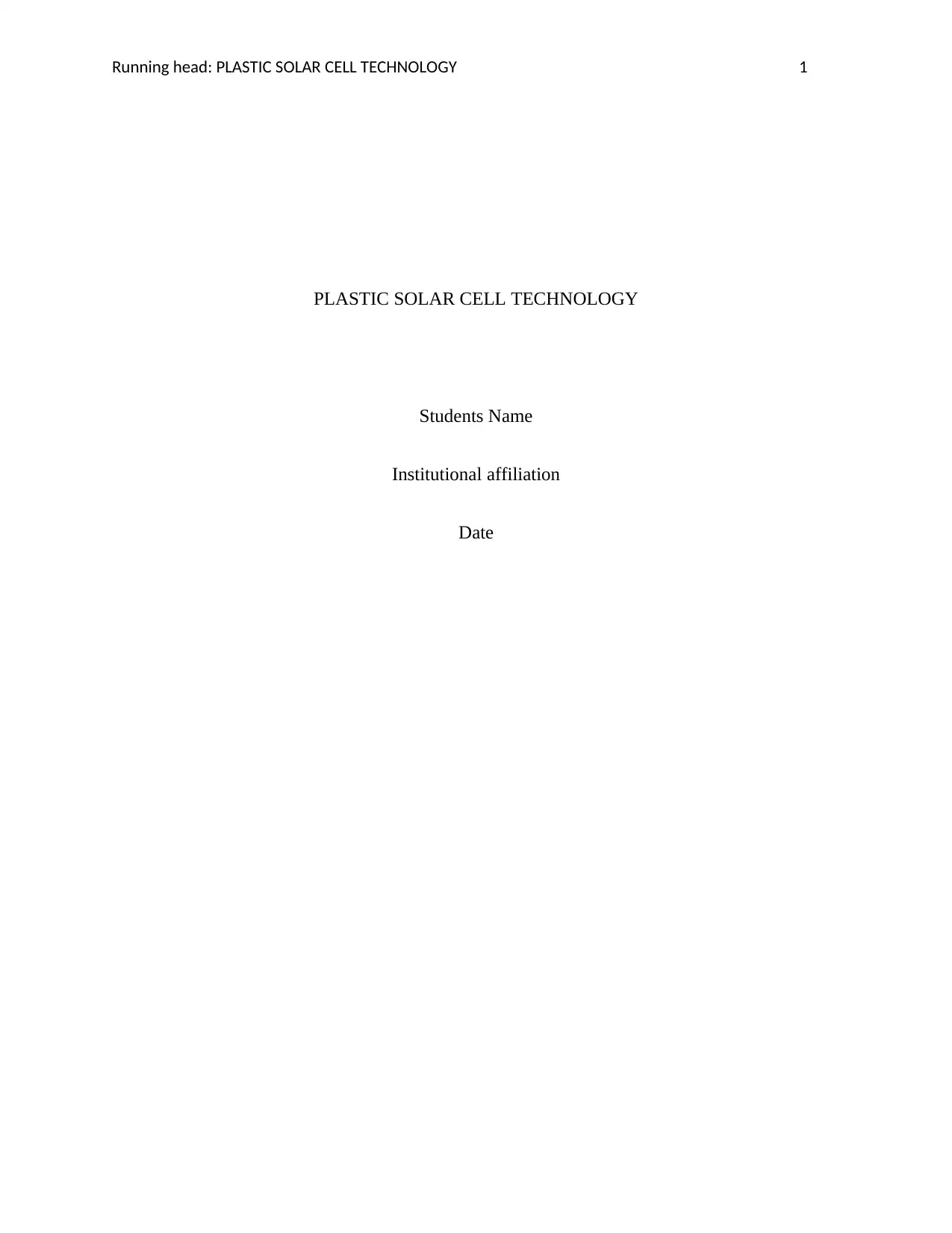
Running head: PLASTIC SOLAR CELL TECHNOLOGY 1
PLASTIC SOLAR CELL TECHNOLOGY
Students Name
Institutional affiliation
Date
PLASTIC SOLAR CELL TECHNOLOGY
Students Name
Institutional affiliation
Date
Paraphrase This Document
Need a fresh take? Get an instant paraphrase of this document with our AI Paraphraser
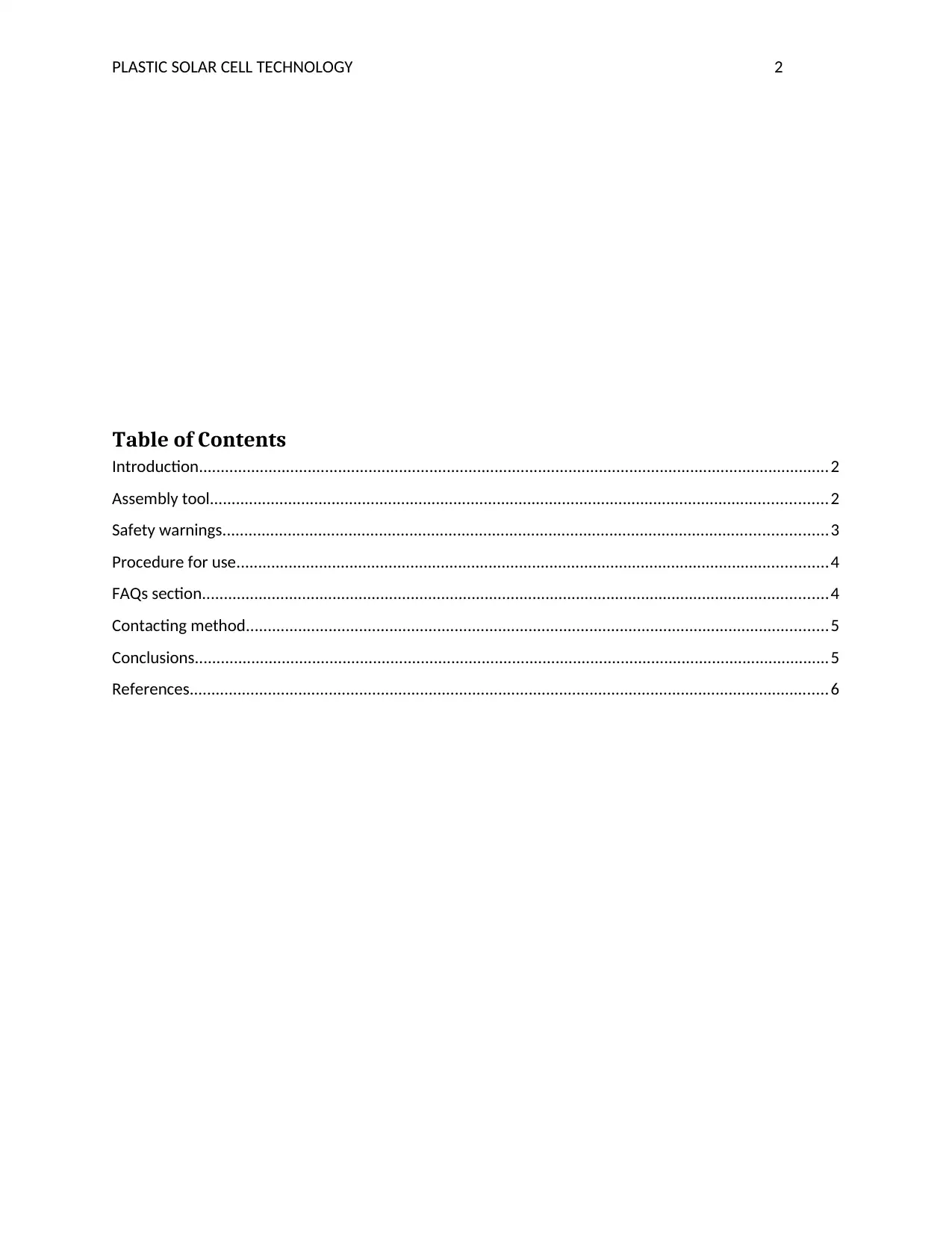
PLASTIC SOLAR CELL TECHNOLOGY 2
Table of Contents
Introduction.................................................................................................................................................2
Assembly tool..............................................................................................................................................2
Safety warnings...........................................................................................................................................3
Procedure for use........................................................................................................................................4
FAQs section................................................................................................................................................4
Contacting method......................................................................................................................................5
Conclusions..................................................................................................................................................5
References...................................................................................................................................................6
Table of Contents
Introduction.................................................................................................................................................2
Assembly tool..............................................................................................................................................2
Safety warnings...........................................................................................................................................3
Procedure for use........................................................................................................................................4
FAQs section................................................................................................................................................4
Contacting method......................................................................................................................................5
Conclusions..................................................................................................................................................5
References...................................................................................................................................................6
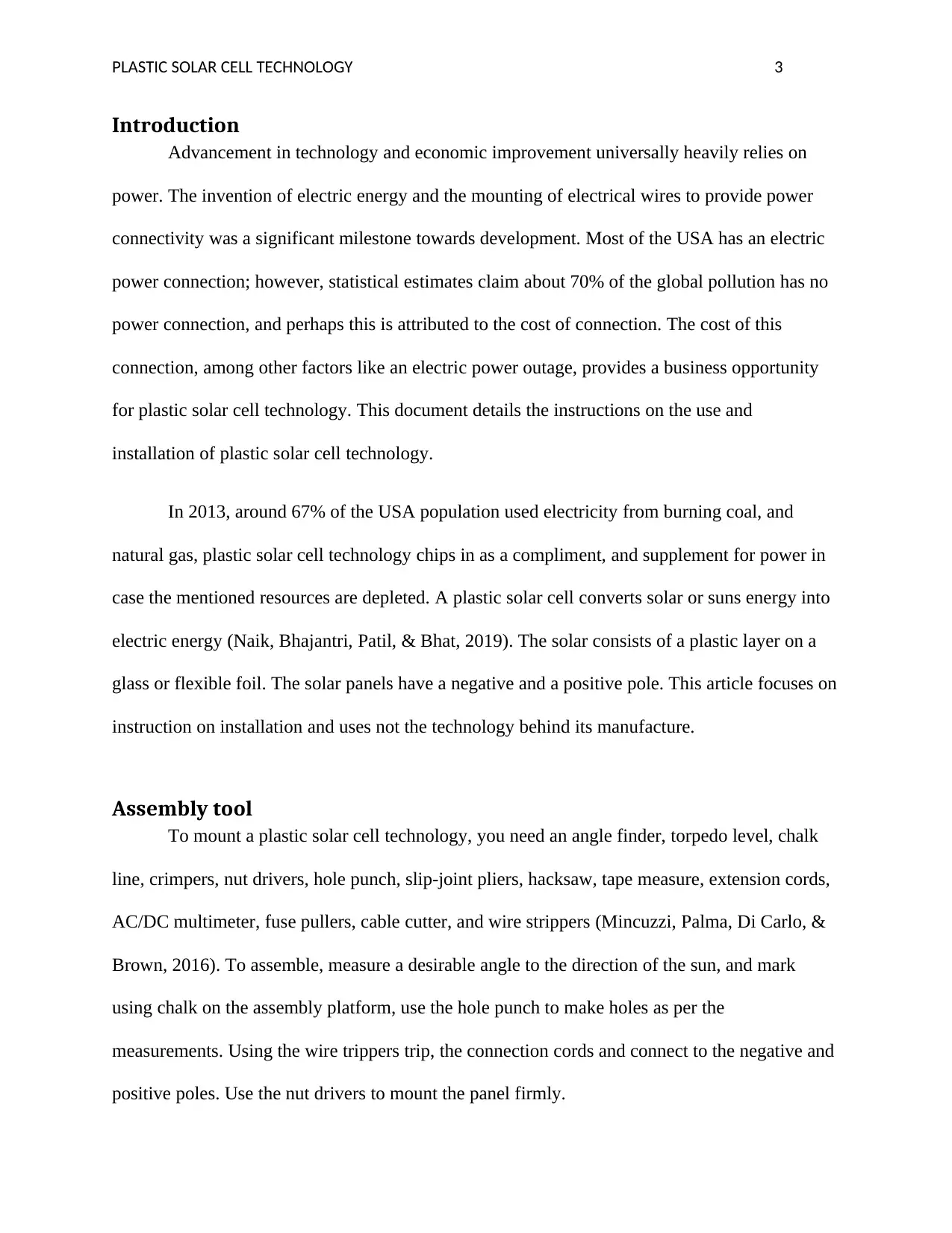
PLASTIC SOLAR CELL TECHNOLOGY 3
Introduction
Advancement in technology and economic improvement universally heavily relies on
power. The invention of electric energy and the mounting of electrical wires to provide power
connectivity was a significant milestone towards development. Most of the USA has an electric
power connection; however, statistical estimates claim about 70% of the global pollution has no
power connection, and perhaps this is attributed to the cost of connection. The cost of this
connection, among other factors like an electric power outage, provides a business opportunity
for plastic solar cell technology. This document details the instructions on the use and
installation of plastic solar cell technology.
In 2013, around 67% of the USA population used electricity from burning coal, and
natural gas, plastic solar cell technology chips in as a compliment, and supplement for power in
case the mentioned resources are depleted. A plastic solar cell converts solar or suns energy into
electric energy (Naik, Bhajantri, Patil, & Bhat, 2019). The solar consists of a plastic layer on a
glass or flexible foil. The solar panels have a negative and a positive pole. This article focuses on
instruction on installation and uses not the technology behind its manufacture.
Assembly tool
To mount a plastic solar cell technology, you need an angle finder, torpedo level, chalk
line, crimpers, nut drivers, hole punch, slip-joint pliers, hacksaw, tape measure, extension cords,
AC/DC multimeter, fuse pullers, cable cutter, and wire strippers (Mincuzzi, Palma, Di Carlo, &
Brown, 2016). To assemble, measure a desirable angle to the direction of the sun, and mark
using chalk on the assembly platform, use the hole punch to make holes as per the
measurements. Using the wire trippers trip, the connection cords and connect to the negative and
positive poles. Use the nut drivers to mount the panel firmly.
Introduction
Advancement in technology and economic improvement universally heavily relies on
power. The invention of electric energy and the mounting of electrical wires to provide power
connectivity was a significant milestone towards development. Most of the USA has an electric
power connection; however, statistical estimates claim about 70% of the global pollution has no
power connection, and perhaps this is attributed to the cost of connection. The cost of this
connection, among other factors like an electric power outage, provides a business opportunity
for plastic solar cell technology. This document details the instructions on the use and
installation of plastic solar cell technology.
In 2013, around 67% of the USA population used electricity from burning coal, and
natural gas, plastic solar cell technology chips in as a compliment, and supplement for power in
case the mentioned resources are depleted. A plastic solar cell converts solar or suns energy into
electric energy (Naik, Bhajantri, Patil, & Bhat, 2019). The solar consists of a plastic layer on a
glass or flexible foil. The solar panels have a negative and a positive pole. This article focuses on
instruction on installation and uses not the technology behind its manufacture.
Assembly tool
To mount a plastic solar cell technology, you need an angle finder, torpedo level, chalk
line, crimpers, nut drivers, hole punch, slip-joint pliers, hacksaw, tape measure, extension cords,
AC/DC multimeter, fuse pullers, cable cutter, and wire strippers (Mincuzzi, Palma, Di Carlo, &
Brown, 2016). To assemble, measure a desirable angle to the direction of the sun, and mark
using chalk on the assembly platform, use the hole punch to make holes as per the
measurements. Using the wire trippers trip, the connection cords and connect to the negative and
positive poles. Use the nut drivers to mount the panel firmly.
⊘ This is a preview!⊘
Do you want full access?
Subscribe today to unlock all pages.

Trusted by 1+ million students worldwide
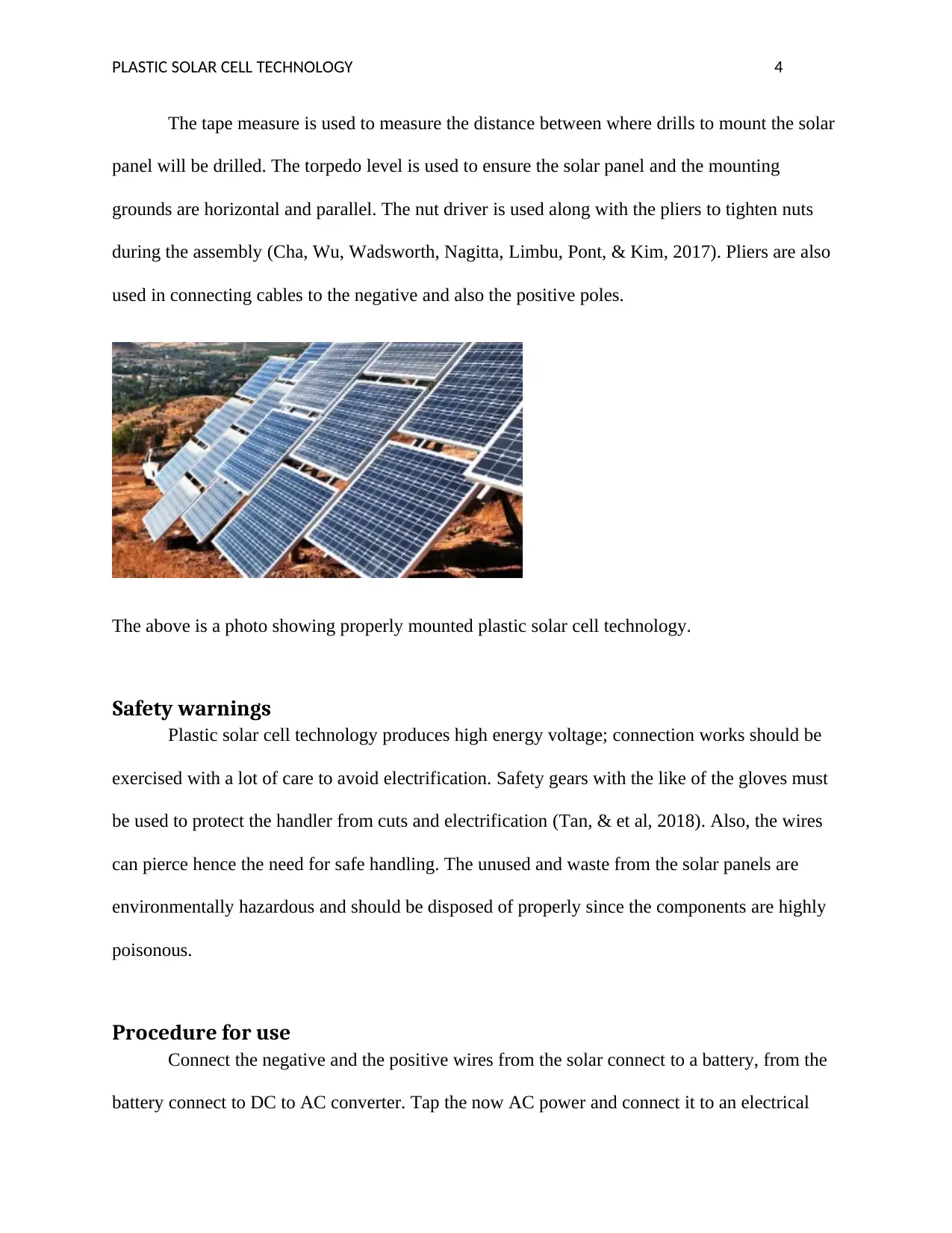
PLASTIC SOLAR CELL TECHNOLOGY 4
The tape measure is used to measure the distance between where drills to mount the solar
panel will be drilled. The torpedo level is used to ensure the solar panel and the mounting
grounds are horizontal and parallel. The nut driver is used along with the pliers to tighten nuts
during the assembly (Cha, Wu, Wadsworth, Nagitta, Limbu, Pont, & Kim, 2017). Pliers are also
used in connecting cables to the negative and also the positive poles.
The above is a photo showing properly mounted plastic solar cell technology.
Safety warnings
Plastic solar cell technology produces high energy voltage; connection works should be
exercised with a lot of care to avoid electrification. Safety gears with the like of the gloves must
be used to protect the handler from cuts and electrification (Tan, & et al, 2018). Also, the wires
can pierce hence the need for safe handling. The unused and waste from the solar panels are
environmentally hazardous and should be disposed of properly since the components are highly
poisonous.
Procedure for use
Connect the negative and the positive wires from the solar connect to a battery, from the
battery connect to DC to AC converter. Tap the now AC power and connect it to an electrical
The tape measure is used to measure the distance between where drills to mount the solar
panel will be drilled. The torpedo level is used to ensure the solar panel and the mounting
grounds are horizontal and parallel. The nut driver is used along with the pliers to tighten nuts
during the assembly (Cha, Wu, Wadsworth, Nagitta, Limbu, Pont, & Kim, 2017). Pliers are also
used in connecting cables to the negative and also the positive poles.
The above is a photo showing properly mounted plastic solar cell technology.
Safety warnings
Plastic solar cell technology produces high energy voltage; connection works should be
exercised with a lot of care to avoid electrification. Safety gears with the like of the gloves must
be used to protect the handler from cuts and electrification (Tan, & et al, 2018). Also, the wires
can pierce hence the need for safe handling. The unused and waste from the solar panels are
environmentally hazardous and should be disposed of properly since the components are highly
poisonous.
Procedure for use
Connect the negative and the positive wires from the solar connect to a battery, from the
battery connect to DC to AC converter. Tap the now AC power and connect it to an electrical
Paraphrase This Document
Need a fresh take? Get an instant paraphrase of this document with our AI Paraphraser
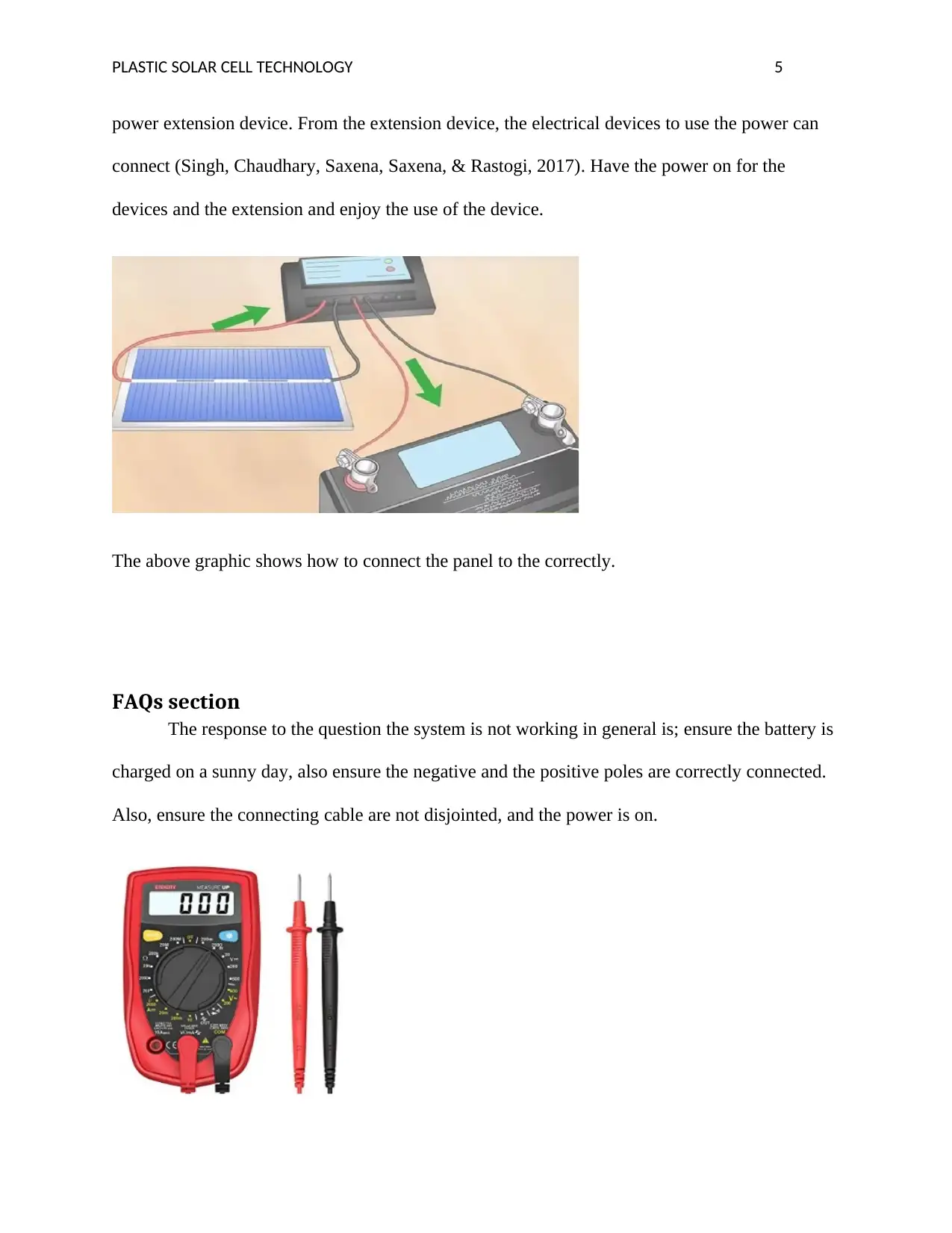
PLASTIC SOLAR CELL TECHNOLOGY 5
power extension device. From the extension device, the electrical devices to use the power can
connect (Singh, Chaudhary, Saxena, Saxena, & Rastogi, 2017). Have the power on for the
devices and the extension and enjoy the use of the device.
The above graphic shows how to connect the panel to the correctly.
FAQs section
The response to the question the system is not working in general is; ensure the battery is
charged on a sunny day, also ensure the negative and the positive poles are correctly connected.
Also, ensure the connecting cable are not disjointed, and the power is on.
power extension device. From the extension device, the electrical devices to use the power can
connect (Singh, Chaudhary, Saxena, Saxena, & Rastogi, 2017). Have the power on for the
devices and the extension and enjoy the use of the device.
The above graphic shows how to connect the panel to the correctly.
FAQs section
The response to the question the system is not working in general is; ensure the battery is
charged on a sunny day, also ensure the negative and the positive poles are correctly connected.
Also, ensure the connecting cable are not disjointed, and the power is on.
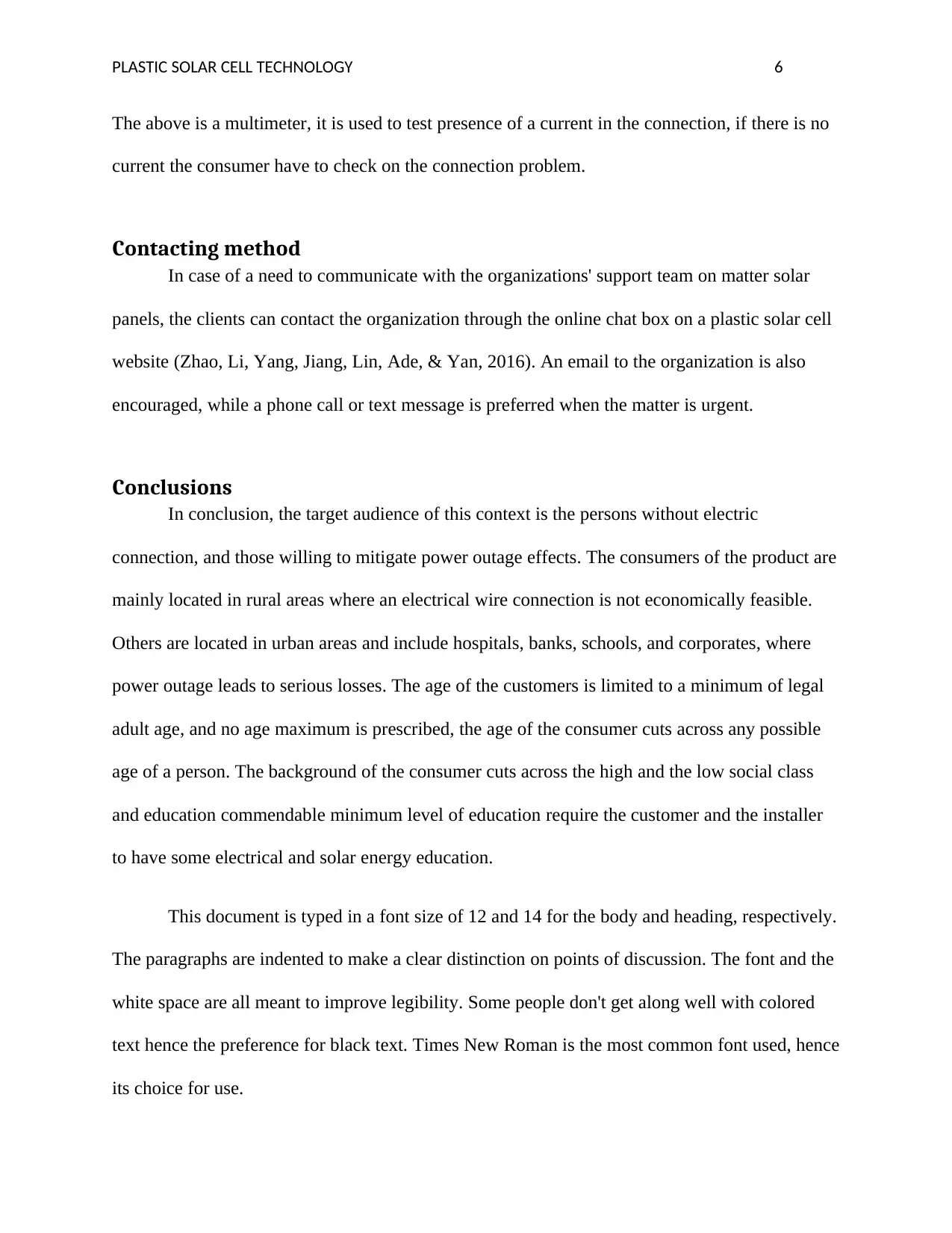
PLASTIC SOLAR CELL TECHNOLOGY 6
The above is a multimeter, it is used to test presence of a current in the connection, if there is no
current the consumer have to check on the connection problem.
Contacting method
In case of a need to communicate with the organizations' support team on matter solar
panels, the clients can contact the organization through the online chat box on a plastic solar cell
website (Zhao, Li, Yang, Jiang, Lin, Ade, & Yan, 2016). An email to the organization is also
encouraged, while a phone call or text message is preferred when the matter is urgent.
Conclusions
In conclusion, the target audience of this context is the persons without electric
connection, and those willing to mitigate power outage effects. The consumers of the product are
mainly located in rural areas where an electrical wire connection is not economically feasible.
Others are located in urban areas and include hospitals, banks, schools, and corporates, where
power outage leads to serious losses. The age of the customers is limited to a minimum of legal
adult age, and no age maximum is prescribed, the age of the consumer cuts across any possible
age of a person. The background of the consumer cuts across the high and the low social class
and education commendable minimum level of education require the customer and the installer
to have some electrical and solar energy education.
This document is typed in a font size of 12 and 14 for the body and heading, respectively.
The paragraphs are indented to make a clear distinction on points of discussion. The font and the
white space are all meant to improve legibility. Some people don't get along well with colored
text hence the preference for black text. Times New Roman is the most common font used, hence
its choice for use.
The above is a multimeter, it is used to test presence of a current in the connection, if there is no
current the consumer have to check on the connection problem.
Contacting method
In case of a need to communicate with the organizations' support team on matter solar
panels, the clients can contact the organization through the online chat box on a plastic solar cell
website (Zhao, Li, Yang, Jiang, Lin, Ade, & Yan, 2016). An email to the organization is also
encouraged, while a phone call or text message is preferred when the matter is urgent.
Conclusions
In conclusion, the target audience of this context is the persons without electric
connection, and those willing to mitigate power outage effects. The consumers of the product are
mainly located in rural areas where an electrical wire connection is not economically feasible.
Others are located in urban areas and include hospitals, banks, schools, and corporates, where
power outage leads to serious losses. The age of the customers is limited to a minimum of legal
adult age, and no age maximum is prescribed, the age of the consumer cuts across any possible
age of a person. The background of the consumer cuts across the high and the low social class
and education commendable minimum level of education require the customer and the installer
to have some electrical and solar energy education.
This document is typed in a font size of 12 and 14 for the body and heading, respectively.
The paragraphs are indented to make a clear distinction on points of discussion. The font and the
white space are all meant to improve legibility. Some people don't get along well with colored
text hence the preference for black text. Times New Roman is the most common font used, hence
its choice for use.
⊘ This is a preview!⊘
Do you want full access?
Subscribe today to unlock all pages.

Trusted by 1+ million students worldwide
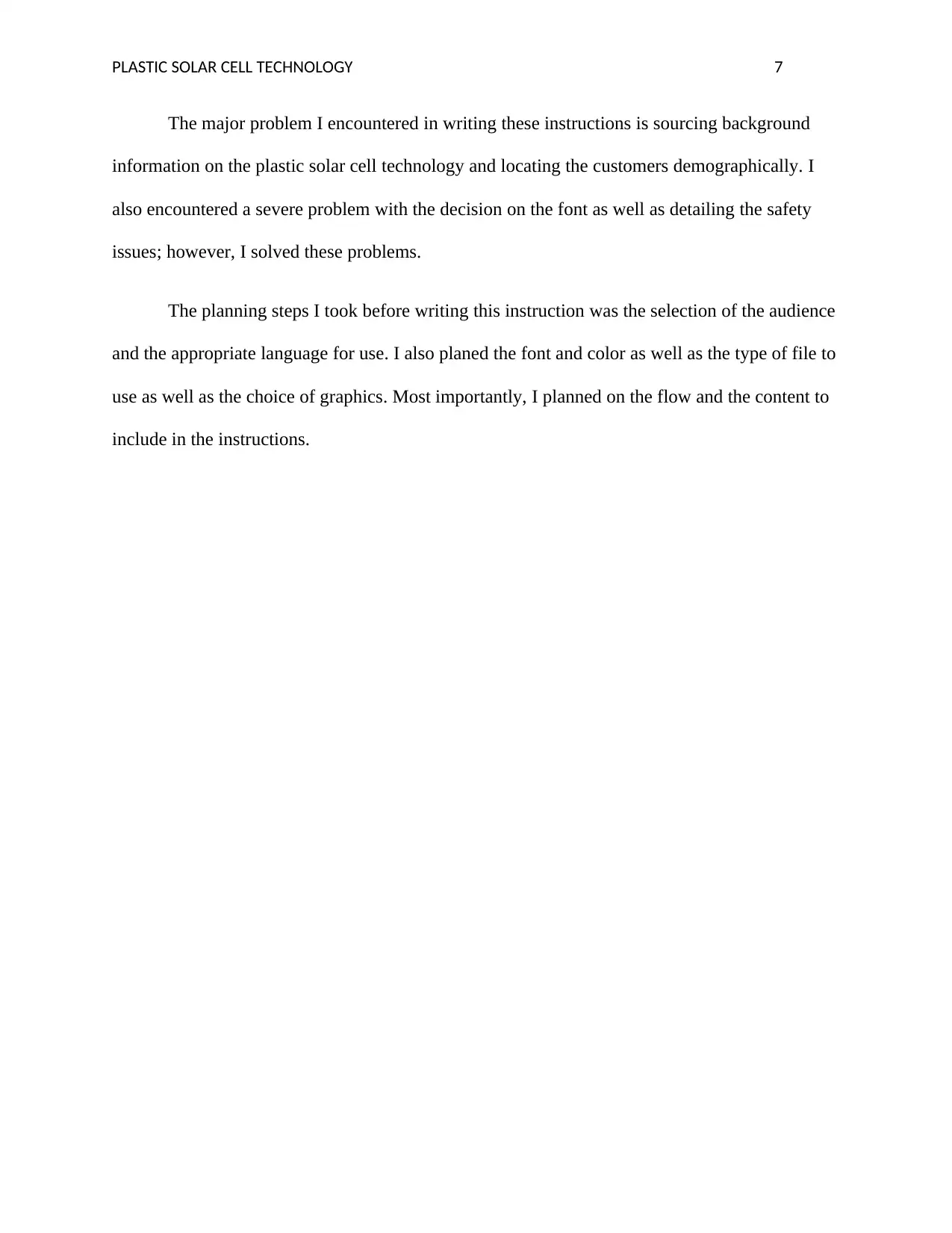
PLASTIC SOLAR CELL TECHNOLOGY 7
The major problem I encountered in writing these instructions is sourcing background
information on the plastic solar cell technology and locating the customers demographically. I
also encountered a severe problem with the decision on the font as well as detailing the safety
issues; however, I solved these problems.
The planning steps I took before writing this instruction was the selection of the audience
and the appropriate language for use. I also planed the font and color as well as the type of file to
use as well as the choice of graphics. Most importantly, I planned on the flow and the content to
include in the instructions.
The major problem I encountered in writing these instructions is sourcing background
information on the plastic solar cell technology and locating the customers demographically. I
also encountered a severe problem with the decision on the font as well as detailing the safety
issues; however, I solved these problems.
The planning steps I took before writing this instruction was the selection of the audience
and the appropriate language for use. I also planed the font and color as well as the type of file to
use as well as the choice of graphics. Most importantly, I planned on the flow and the content to
include in the instructions.
Paraphrase This Document
Need a fresh take? Get an instant paraphrase of this document with our AI Paraphraser
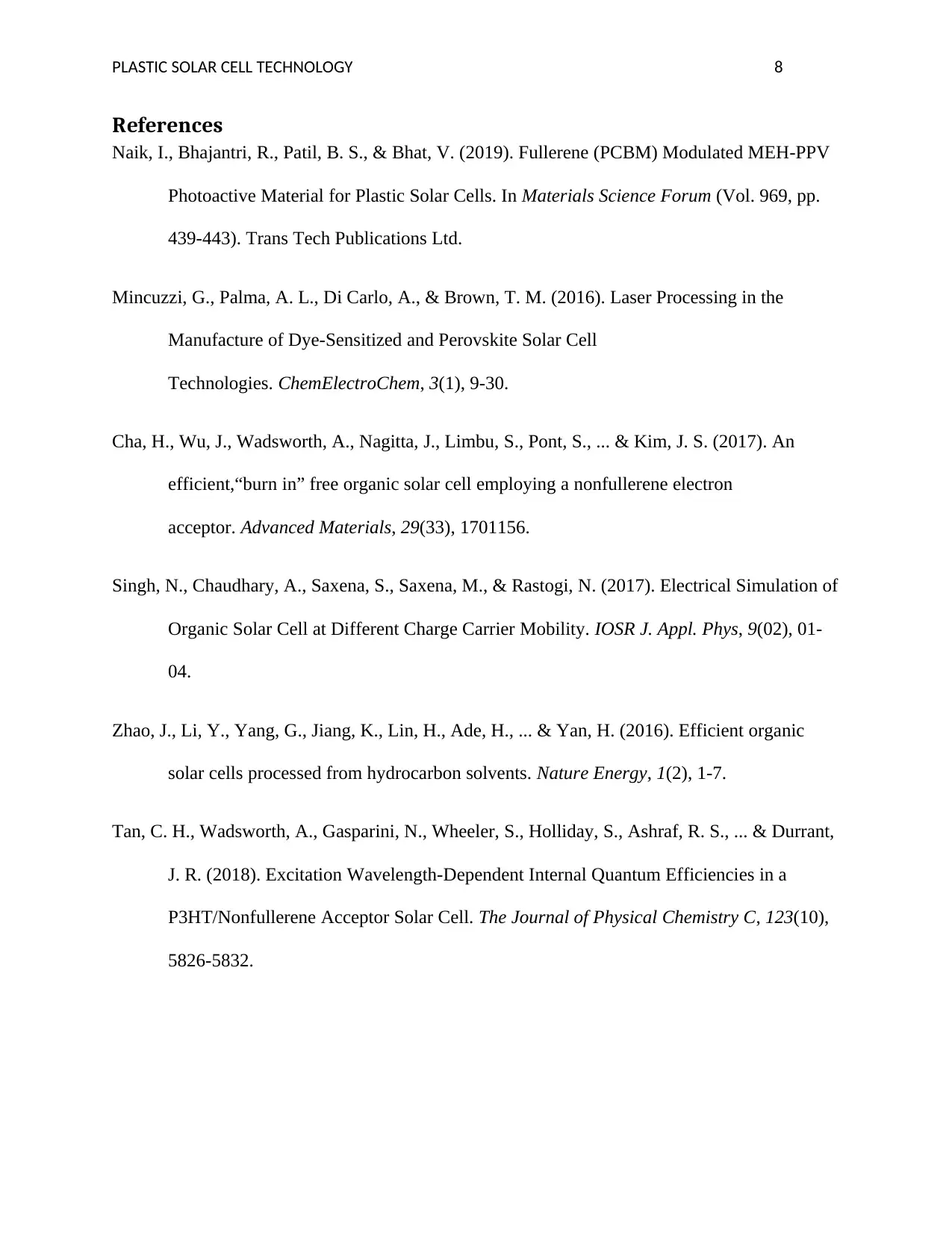
PLASTIC SOLAR CELL TECHNOLOGY 8
References
Naik, I., Bhajantri, R., Patil, B. S., & Bhat, V. (2019). Fullerene (PCBM) Modulated MEH-PPV
Photoactive Material for Plastic Solar Cells. In Materials Science Forum (Vol. 969, pp.
439-443). Trans Tech Publications Ltd.
Mincuzzi, G., Palma, A. L., Di Carlo, A., & Brown, T. M. (2016). Laser Processing in the
Manufacture of Dye‐Sensitized and Perovskite Solar Cell
Technologies. ChemElectroChem, 3(1), 9-30.
Cha, H., Wu, J., Wadsworth, A., Nagitta, J., Limbu, S., Pont, S., ... & Kim, J. S. (2017). An
efficient,“burn in” free organic solar cell employing a nonfullerene electron
acceptor. Advanced Materials, 29(33), 1701156.
Singh, N., Chaudhary, A., Saxena, S., Saxena, M., & Rastogi, N. (2017). Electrical Simulation of
Organic Solar Cell at Different Charge Carrier Mobility. IOSR J. Appl. Phys, 9(02), 01-
04.
Zhao, J., Li, Y., Yang, G., Jiang, K., Lin, H., Ade, H., ... & Yan, H. (2016). Efficient organic
solar cells processed from hydrocarbon solvents. Nature Energy, 1(2), 1-7.
Tan, C. H., Wadsworth, A., Gasparini, N., Wheeler, S., Holliday, S., Ashraf, R. S., ... & Durrant,
J. R. (2018). Excitation Wavelength-Dependent Internal Quantum Efficiencies in a
P3HT/Nonfullerene Acceptor Solar Cell. The Journal of Physical Chemistry C, 123(10),
5826-5832.
References
Naik, I., Bhajantri, R., Patil, B. S., & Bhat, V. (2019). Fullerene (PCBM) Modulated MEH-PPV
Photoactive Material for Plastic Solar Cells. In Materials Science Forum (Vol. 969, pp.
439-443). Trans Tech Publications Ltd.
Mincuzzi, G., Palma, A. L., Di Carlo, A., & Brown, T. M. (2016). Laser Processing in the
Manufacture of Dye‐Sensitized and Perovskite Solar Cell
Technologies. ChemElectroChem, 3(1), 9-30.
Cha, H., Wu, J., Wadsworth, A., Nagitta, J., Limbu, S., Pont, S., ... & Kim, J. S. (2017). An
efficient,“burn in” free organic solar cell employing a nonfullerene electron
acceptor. Advanced Materials, 29(33), 1701156.
Singh, N., Chaudhary, A., Saxena, S., Saxena, M., & Rastogi, N. (2017). Electrical Simulation of
Organic Solar Cell at Different Charge Carrier Mobility. IOSR J. Appl. Phys, 9(02), 01-
04.
Zhao, J., Li, Y., Yang, G., Jiang, K., Lin, H., Ade, H., ... & Yan, H. (2016). Efficient organic
solar cells processed from hydrocarbon solvents. Nature Energy, 1(2), 1-7.
Tan, C. H., Wadsworth, A., Gasparini, N., Wheeler, S., Holliday, S., Ashraf, R. S., ... & Durrant,
J. R. (2018). Excitation Wavelength-Dependent Internal Quantum Efficiencies in a
P3HT/Nonfullerene Acceptor Solar Cell. The Journal of Physical Chemistry C, 123(10),
5826-5832.
1 out of 8
Your All-in-One AI-Powered Toolkit for Academic Success.
+13062052269
info@desklib.com
Available 24*7 on WhatsApp / Email
![[object Object]](/_next/static/media/star-bottom.7253800d.svg)
Unlock your academic potential
Copyright © 2020–2025 A2Z Services. All Rights Reserved. Developed and managed by ZUCOL.